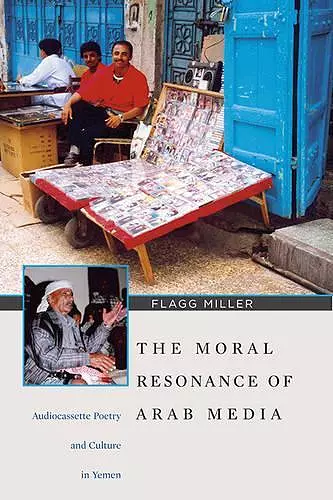The Moral Resonance of Arab Media
Audiocassette Poetry and Culture in Yemen
Format:Paperback
Publisher:Harvard University Press
Published:30th Oct '07
Currently unavailable, and unfortunately no date known when it will be back

In a groundbreaking study of contemporary Arab political poetry, Flagg Miller provides a wide range of insights into the ways that modern media aesthetics are shaped by language and culture. Investigating a vibrant audio-recording industry in southern Yemen, The Moral Resonance of Arab Media shows how new forms of political activism emerge through sensory engagements with Arabic poetry and song. From the 1940s onward, a new cadre of political activists has used audio-recording technologies, especially the audiocassette, to redefine traditional Muslim authorship.
Cassette producers address conflicted views about the resurgence of tribalism by showing Yemenis how to adapt traditional mores toward more progressive and pluralistic aims. Skilled bards continue to perform orally marked tribal verse. As Miller demonstrates through an analysis of several centuries of changing media ecology, however, oral performance is anything but static. Much of the power of orality stems from its relation to writing, print, and audiovisual media that link tribal ideals with metropolitan and national discourses. Through an examination of the lives and works of individual poets, singers, and audiences, Moral Resonance shows how tribalism becomes a resource for critical reform when expressed in tropes of community, place, person, and history. Yemenis’ use of audiocassettes turns such tropes into cultural resources for morally evaluating political liberalism.
This brilliant interdisciplinary work on media and tribal poetry in Yemen by a superb Arabist is at once a significant contribution to media studies, linguistic pragmatics, poetics, and the anthropology of the Middle East. The scholarship is thorough, carefully building on previous research, but also departing from it in original and imaginative ways… While acknowledging that the two aesthetics of circulation and resonance are integral to each other, Miller argues that it is particularly the aesthetics of ‘resonance’ that is important to understanding how moral authority, political order (or disorder), and artistic success are debated by Yemenis. This idea, and the claims the author makes for it, will surely occasion lively discussion and debate. -- Steven C. Caton * Middle East Journal *
- Nominated for Albert Hourani Book Award 2008
- Nominated for Victor Turner Prize in Ethnographic Writing 2008
ISBN: 9780932885326
Dimensions: 210mm x 140mm x 34mm
Weight: 635g
512 pages